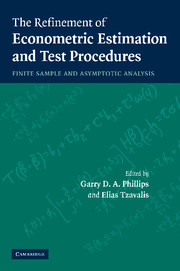Book contents
- Frontmatter
- Contents
- List of figures
- List of tables
- List of contributors
- Preface
- Acknowledgements
- Michael Magdalinos 1949–2002
- Introduction
- 1 Conditional Heteroskedasticity Models with Pearson Disturbances
- 2 The Instrumental Variables Method Revisited: On the Nature and Choice of Optimal Instruments
- 3 Nagar-Type Moment Approximations in Simultaneous Equation Models: Some Further Results
- 4 Local GEL Methods for Conditional Moment Restrictions
- 5 Limit Theory for Moderate Deviations From a Unit Root Under Weak Dependence
- 6 The Structure of Multiparameter Tests
- 7 Cornish-Fisher Size Corrected t and F Statistics for the Linear Regression Model with Heteroscedastic Errors
- 8 Non-Parametric Specification Testing of Non-Nested Econometric Models
- 9 Testing for Autocorrelation in Systems of Equations
- 10 Alternative Approaches to Estimation and Inference in Large Multifactor Panels: Small Sample Results with an Application to Modelling Asset Returns
- 11 Judging Contending Estimators by Simulation: Tournaments in Dynamic Panel Data Models
- 12 A Statistical Proof of the Transformation Theorem
- 13 On the Joint Density of the Sum and Sum of Squares of Non-Negative Random Variables
- 14 Conditional Response Analysis
- References
- Index
12 - A Statistical Proof of the Transformation Theorem
Published online by Cambridge University Press: 22 September 2009
- Frontmatter
- Contents
- List of figures
- List of tables
- List of contributors
- Preface
- Acknowledgements
- Michael Magdalinos 1949–2002
- Introduction
- 1 Conditional Heteroskedasticity Models with Pearson Disturbances
- 2 The Instrumental Variables Method Revisited: On the Nature and Choice of Optimal Instruments
- 3 Nagar-Type Moment Approximations in Simultaneous Equation Models: Some Further Results
- 4 Local GEL Methods for Conditional Moment Restrictions
- 5 Limit Theory for Moderate Deviations From a Unit Root Under Weak Dependence
- 6 The Structure of Multiparameter Tests
- 7 Cornish-Fisher Size Corrected t and F Statistics for the Linear Regression Model with Heteroscedastic Errors
- 8 Non-Parametric Specification Testing of Non-Nested Econometric Models
- 9 Testing for Autocorrelation in Systems of Equations
- 10 Alternative Approaches to Estimation and Inference in Large Multifactor Panels: Small Sample Results with an Application to Modelling Asset Returns
- 11 Judging Contending Estimators by Simulation: Tournaments in Dynamic Panel Data Models
- 12 A Statistical Proof of the Transformation Theorem
- 13 On the Joint Density of the Sum and Sum of Squares of Non-Negative Random Variables
- 14 Conditional Response Analysis
- References
- Index
Summary
Introduction
Let x ∈ χ be an m × 1 variate with a known distribution. Suppose x is transformedinto a new n × 1 variate defined by the deterministic function y := g(x) ∈ Y. What are the statistical properties of y? More specifically, how can we express the distribution of y in terms of the (known) distribution of x? Three main methods are available: the moment-generating function (m.g.f.) or characteristic function (c.f.) technique, the cumulative distribution function (c.d.f.) technique, and the probability density function (p.d.f.) technique.
The transformation theorem relates to the p.d.f. technique when the variates are continuous, and is our focus here. The theorem is difficult and lengthy to prove, typically relying on advanced results in analysis, on differential forms and changes of variables of integration, see for example Wilks (1962, pp. 53–9) and Rao (1973, pp. 156–7) for statements and discussions, and Rudin (1976, ch. 10) for a proof. It is one of the very few major statistical theorems for which there is no proof in the statistics literature. Here, we provide a simple proof, by exploiting the statistical context that it is a density function whose arguments are being transformed. The proof uses the idea of conditioning for continuous random variables. It also illustrates how conditioning can provide shortcuts to proofs by reducing the dimensionality of some statistical problems.
- Type
- Chapter
- Information
- The Refinement of Econometric Estimation and Test ProceduresFinite Sample and Asymptotic Analysis, pp. 319 - 325Publisher: Cambridge University PressPrint publication year: 2007
- 1
- Cited by



